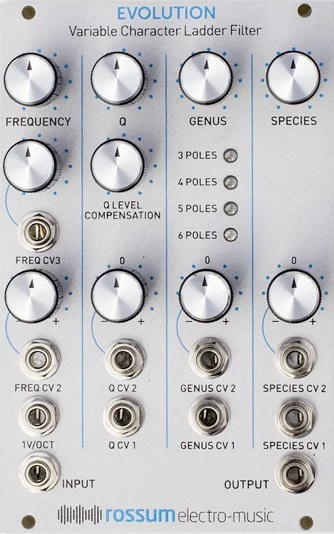hairmetal81
Registrierter Benutzer
- Zuletzt hier
- 30.03.17
- Registriert
- 20.08.12
- Beiträge
- 12.517
- Kekse
- 33.686
Bei Dave Rossum ist es jetzt wohl amtlich:

Dave Rossum Music to Release E-Mu Morpheus Filter in Eurorack Format


"The Evolution of EVOLUTION
The fundamental core of the Rossum Electro-Music EVOLUTION Variable Character Filter is Bob Moog’s famous “ladder” filter, which was described in US Patent 3,475,623. This circuit uses the variation of the Bipolar Junction Transistor’s emitter resistance with current as the voltage variable element in an RC filter. In the Moog implementation, four identical stages each implemented a single real lowpass pole. The Moog 904A module included a “Regeneration” control that created a negative feedback path around the four poles. Since each pole provided 45 degrees of phase shift at its -3dB point, increasing this feedback produced a resonant peak at cutoff. The musical utility of the Moog filter is, of course, famous.
In 1973, E-mu Systems introduced their 1100 submodule, which was the heart of their 2100 lowpass filter module. The 1100 used a Moog ladder as its core element, but I wanted to isolate the innate audio characteristics of the filter ladder from those colorations resulting from the input level-shifters and output amplifier used in the Moog 904A. I also envisioned a DC-coupled design with a cutoff frequency range well beyond 10 octaves, as well as eliminating variations of the height of the resonant peak or oscillation amplitude with frequency control voltage.
I level-shifted the exponential generator to allow the filter signal input to be directly applied to the ladder base. I then designed a completely new output stage for the ladder; this circuit has never (to our knowledge) been used outside my designs. The entire signal path was DC coupled and the resonant feedback path phase compensated. The 1100 was my favorite filter (I liked it more than the SSM2040 I later invented, and kept the 1100 as E-mu’s modular lowpass in preference to a cheaper 2040 design). The operational range of the cutoff frequency was from about 0.1Hz to 25kHz, with stable Q’s throughout.
In launching Rossum Electro-Music, I chose a new implementation of the 1100 filter as the first all-analog module for our Eurorack offering, based on its unique and outstanding audio characteristics. I re-engineered the basic 1100 core using modern available surface-mount components and then added a number of features to the original 1100 design:
Ladder filters self-oscillate, and can be used as VCOs. I was able to design the Rossum Electro EVOLUTION’s frequency control exponential generator to be extremely accurate and temperature stable, rivaling the specifications of the best analog VCOs. I also added a novel temperature compensation circuit for the ladder emitter resistance.
The resonance (“Q”) of the original 1100 was not voltage controlled. I implemented voltage controlled Q using one cell of an SSM2164 VCA (sadly, the original 2164 is no longer produced, so a replica source is needed). Since the SSM2164 is based on my 1979 design of the SSM2010, this is an apt choice. The phase compensation has been maintained, but we added a “Q Compensation” control. The negative feedback resonance path in the 1100, like the Moog 904A, caused the amplitude of signals in the passband to be attenuated as the Q increased, which some users found undesirable. If instead the signal is inserted into the Q VCA, this effect is eliminated. In EVOLUTION, the Q Compensation control allows insertion of the signal with an arbitrary mix into either of these inputs, allowing the ratio of direct to resonant amplitude to be arbitrarily selected.
There is no inherently desirable taper for Q control. In highly resonant, but oscillation-proof filters such as state variable designs, it makes sense to exponentially control Q. But in ladder filters, oscillation is expected, and high Q’s without oscillation are not practically achievable. The Rossum Electro EVOLUTION implements linear control of the Q VCA.
The ladder design, as I implemented it, has no inherent distortion for signals far below the cutoff frequency. The characteristic timbre of the filter comes primarily from distortions of frequencies near and above the cutoff frequency. The degree of distortion depends on the signal amplitude. Consequently, it is sonically interesting to modulate the signal amplitude going into the ladder, and modulate the output signal with the precise inverse gain. This is the function of the Species control. A high voltage into the Species input will cause the filter to distort more audibly.
Because ladder filters produce their resonance by feedback, the relationship of that feedback to the drive VCAs is critical. The Rossum Electro EVOLUTION places the Q feedback within the drive VCAs. This means that the filter’s resonance is unaffected by the Species setting, but that the amplitude of any self-oscillation will be inversely proportional to the Species level. When using the filter as an oscillator, the Species control can be used to amplitude modulate the output. If oscillation is combined with an input signal, the results become even more interesting. Like the Q circuit, SSM 2164 cells are used for the drive VCAs.
With these additions, the preliminary design of EVOLUTION looked pretty complete. Then Marco asked if it would be possible to add voltage controlled slope (those marketing guys are never satisfied). My first take was that this would not be practical, because varying the slope usually involves controlling complex pole pairs, and the ladder comprises only real poles.
Then I realized that I could steer the current around individual ladder stages in an analog manner, controlling the number of poles rather than the slope. A prototype proved this was both practical and audibly pleasing. Since the resonant frequency of a ladder filter is determined by the 180 degree phase shift point, it changes with the number of poles: 60 degrees for three poles, 45 for four, 36 for five, and 30 degrees for six poles. Modulating the number of poles produces a unique 'bubbly' sound.
Two more tweaks were needed to complete the circuit. Because the number of poles not only affects the phase shift for resonance, it also changes the amount of feedback required for oscillation, the pole control circuit needs to control the Q VCA in a manner such that the same Q control voltage produces oscillation for each pole setting. And since it’s useful but difficult to tune the initial pole setting to be in the center of the range (exactly steering the current to the desired ladder poles), I added analog controlled LEDs to indicate the activation of the poles."
"EVOLUTION is Dave’s updated take on his classic enhancement of Bob Moog’s iconic ladder filter.
At the core of EVOLUTION is Dave’s unique implementation of the Moog ladder filter from the original E-mu Systems 2100 LPF module (which, incidentally, Dave counts as his favorite of all of the analog filters he designed).
For EVOLUTION, Dave has designed new capabilities that not only allow users to dial in all of the outstanding qualities of the original 2100, but combine to let them create the sonic characteristics of a wide variety of other filter types. They include:
– A Genus control that allows continuous voltage control of the number of filter poles (from 3 to 6 poles), essentially allowing real-time variation of Evolution’s effective cutoff slope from 18dB/oct to 36dB/oct. LEDs give continuous indication of the current slope.
– A Species control that allows voltage control of the signal level into Evolution’s unique distortion circuitry.
– Voltage controlled resonance with a variable Q Level Compensation control that controls of the balance of the resonant signal and the frequencies below the cutoff frequency (which would otherwise be attenuated as the resonance is increased).
– An extremely accurate and temperature-stable frequency control exponential generator, rivaling the specifications of the best analog VCOs.Taken together, EVOLUTION gives everything from the platonic ideal of the classic ladder filter to an almost unlimited variety of alternative filter characteristics."






 Ausgerechnet Music Trades... gib Yamaha Montage in Google ein ...du findest nichts! ...aber mal bei Music Trades zu gucken - warum bin ich da nicht selbst drauf gekommen?
Ausgerechnet Music Trades... gib Yamaha Montage in Google ein ...du findest nichts! ...aber mal bei Music Trades zu gucken - warum bin ich da nicht selbst drauf gekommen? ]
]






